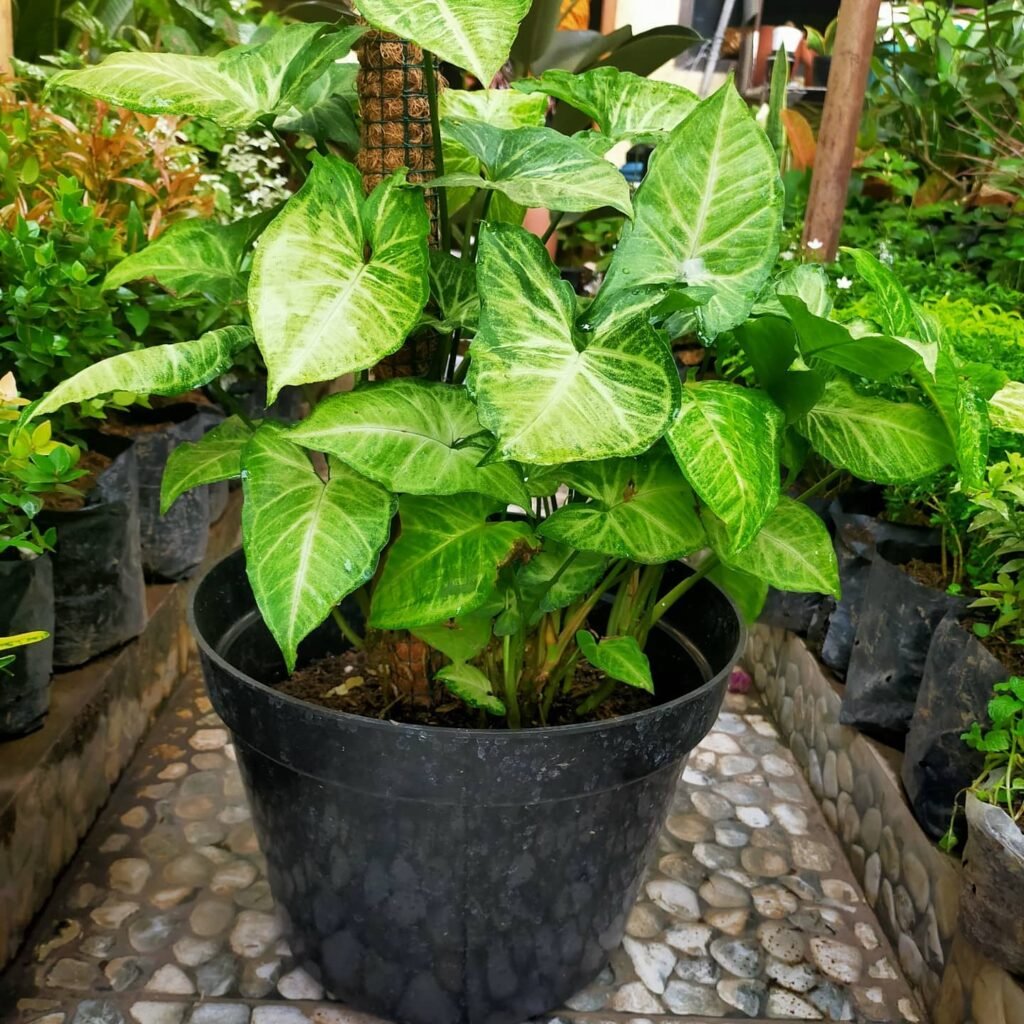Have you ever wanted to bring a touch of nature into your home? To create a cozy and inviting space where you can relax and unwind? Well, look no further than the Syngonium podophyllum, also known as the Arrowhead Vine. This delightful houseplant is not only easy to care for but also offers a stunning variety of leaf colors and patterns to suit any interior.
Let me share a personal story with you. Last year, I decided to transform my living room into an urban jungle. I wanted to surround myself with plants that would breathe life into my space. That’s when I discovered the Syngonium podophyllum. Its unique arrowhead-shaped leaves, ranging from vibrant greens to beautiful variegations, instantly caught my eye.
With its low-maintenance nature, the Arrowhead Vine quickly became the focal point of my indoor sanctuary. Its versatility allowed me to place it on shelves, hang it in baskets, or let it cascade over the edge of a bookshelf. The possibilities were endless, and the plant thrived in every corner.
But caring for the Syngonium podophyllum was not only a delight but also a responsibility. I learned that it needed bright, indirect light to flourish and grow. I positioned it near a window, where the filtered sunlight enhanced its colors and patterns. I also discovered the importance of watering it regularly, allowing the top inch of soil to dry out between waterings.
As I cared for my Arrowhead Vine, I realized that it was not just a beautiful decoration but also a living being that brought joy and tranquility into my home. Its vibrant foliage became a conversation starter and a testament to my dedication to creating a harmonious living space.
Appearance of Syngonium podophyllum (Arrowhead Vine)
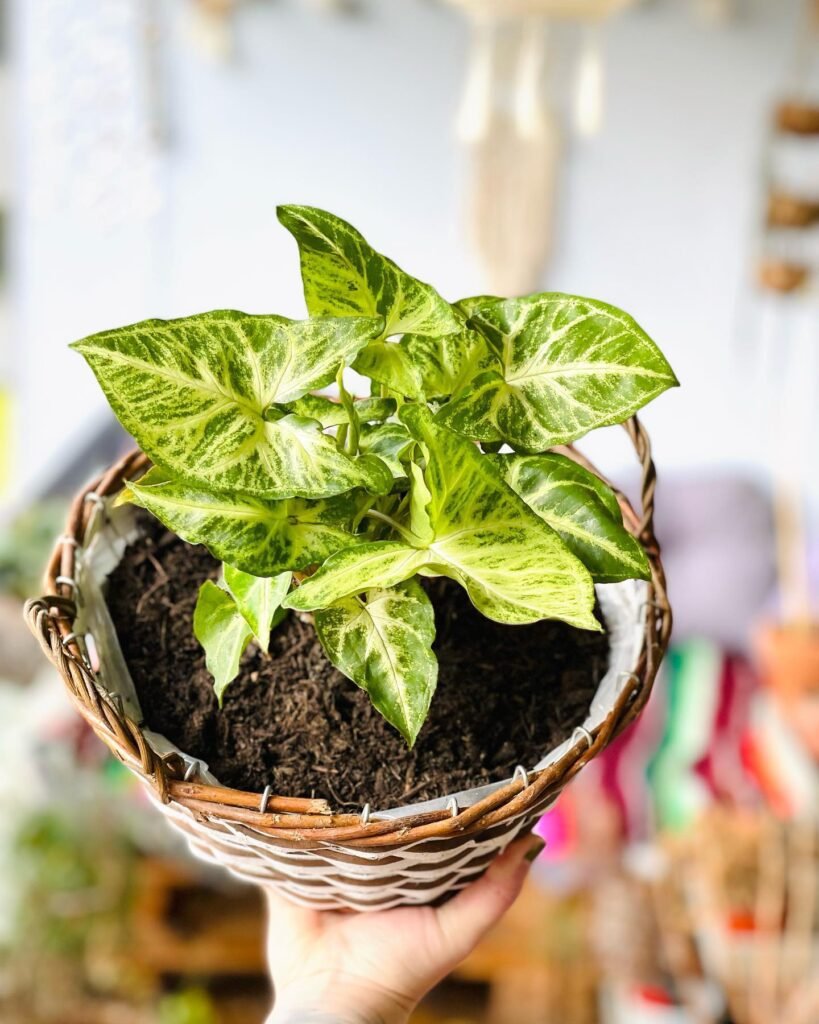

Syngonium podophyllum, also known as Arrowhead Vine, is a stunning houseplant with leaves that resemble the shape of an arrowhead or a goose’s foot. The plant comes in a variety of leaf colors and patterns, offering a beautiful display of nature’s artwork.
From shades of vibrant green to soft hues of pink, the leaves of Syngonium podophyllum are a sight to behold. In addition to their stunning colors, the leaves often feature unique patterns like speckles or marbling, adding an extra touch of uniqueness to each plant. The variegated varieties of Syngonium podophyllum are particularly sought after, with their striking contrast between light and dark shades.
“The leaves of Syngonium podophyllum are like living canvases, showcasing nature’s creativity in a beautiful array of colors and patterns.”
Whether you prefer a classic green look or a bold variegated style, the diverse range of Syngonium podophyllum varieties allows you to find a plant that suits your personal taste and complements your interior decor.
 Did you know the Arrowhead Vine is cherished for its beauty and its historical use in traditional remedies? It’s been part of natural treatments for wounds and fevers, adding an intriguing layer to this attractive plant.
Did you know the Arrowhead Vine is cherished for its beauty and its historical use in traditional remedies? It’s been part of natural treatments for wounds and fevers, adding an intriguing layer to this attractive plant.
Light Requirements for Syngonium podophyllum
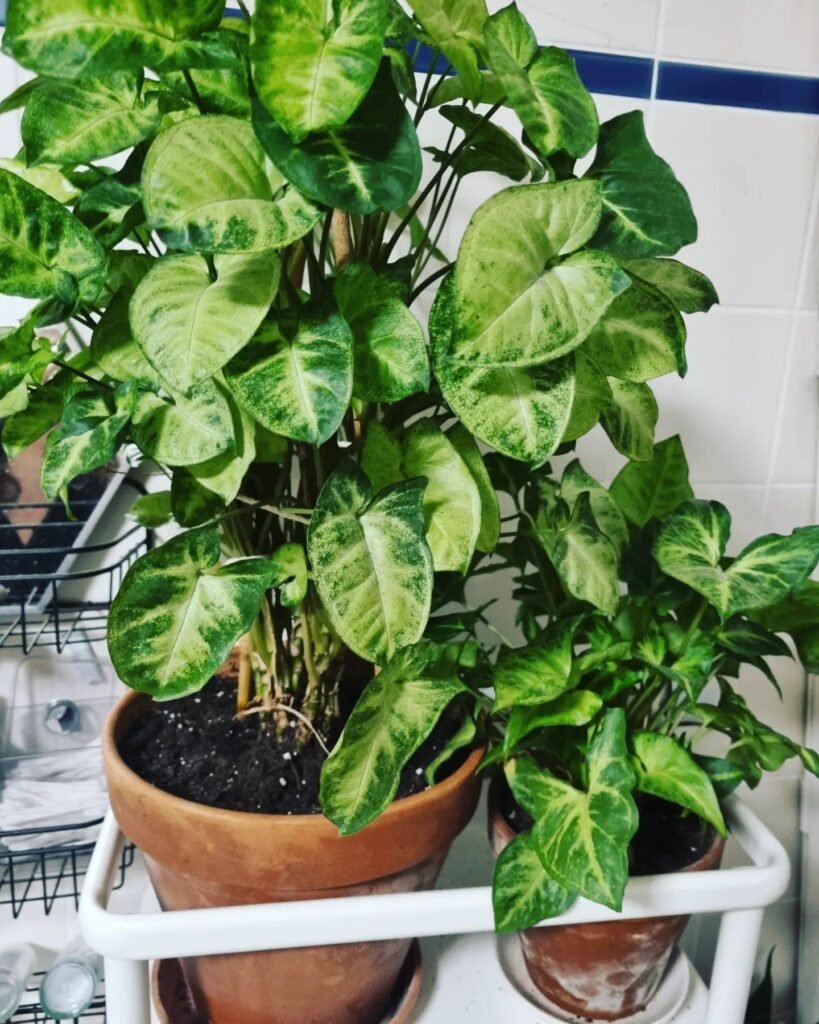
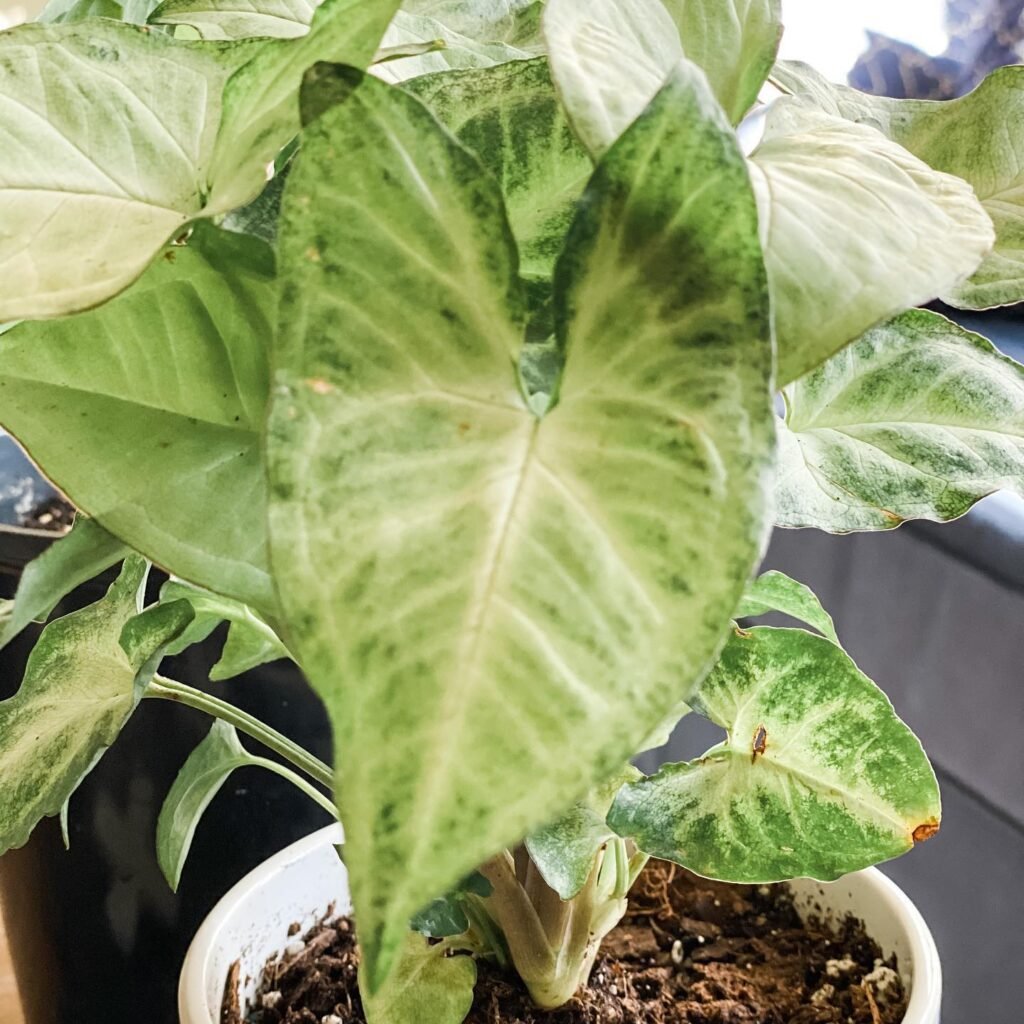
Syngonium podophyllum, commonly known as Arrowhead Vine, is an ideal indoor plant for your UK home. To ensure its healthy growth, it is important to provide the right amount of light.
Syngonium podophyllum thrives in bright, indirect light. It should be placed in a location with filtered sunlight, preferably near a window. Direct sunlight should be avoided as it can scorch the leaves.
While Syngoniums are tolerant of lower light conditions, they will show more vibrant leaf colors and faster growth in indirect, bright light. So, if your indoor space doesn’t receive a lot of natural light, you can still enjoy the beauty of Syngonium by providing it with a bright, well-lit area.
“Bright, indirect light is the key to keeping your Syngonium podophyllum happy and thriving.”
Remember to regularly rotate your Syngonium plant to ensure even growth, as it tends to grow towards the light source. This rotation will help maintain a uniform shape and prevent it from leaning towards one side.
So, find the perfect spot for your Syngonium podophyllum where it can bask in the right amount of filtered light, and watch it flourish and beautify your indoor space.

Watering Tips for Syngonium podophyllum (Arrowhead Vine)
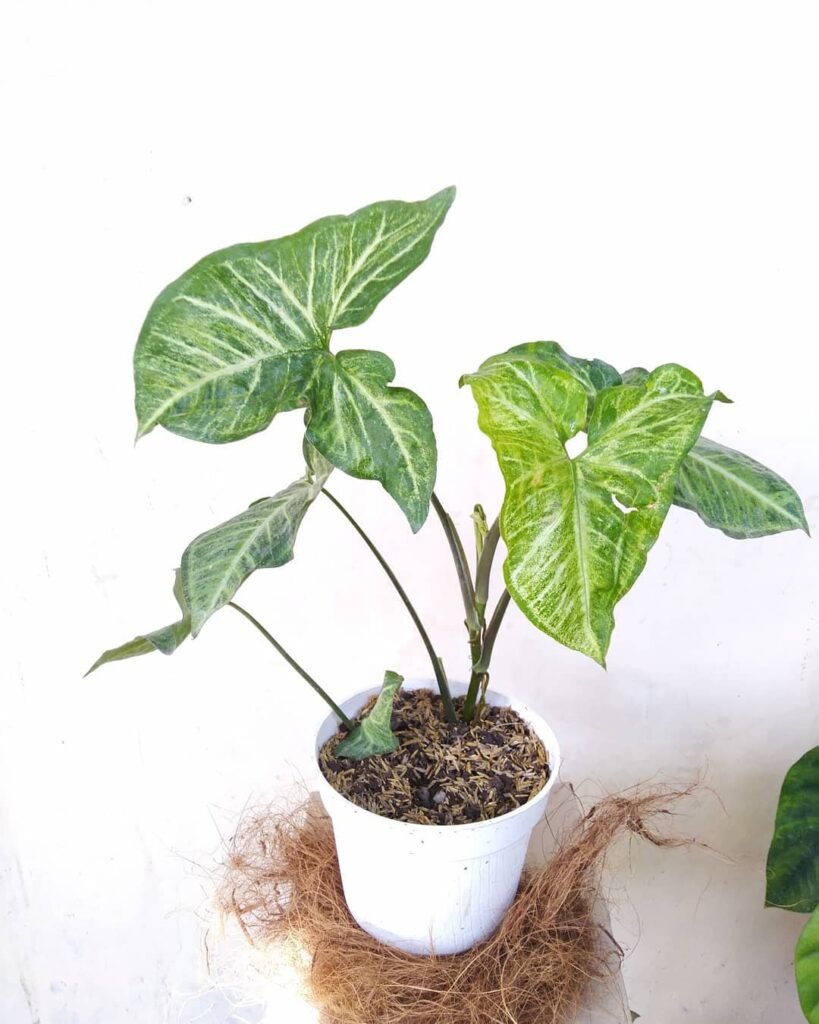
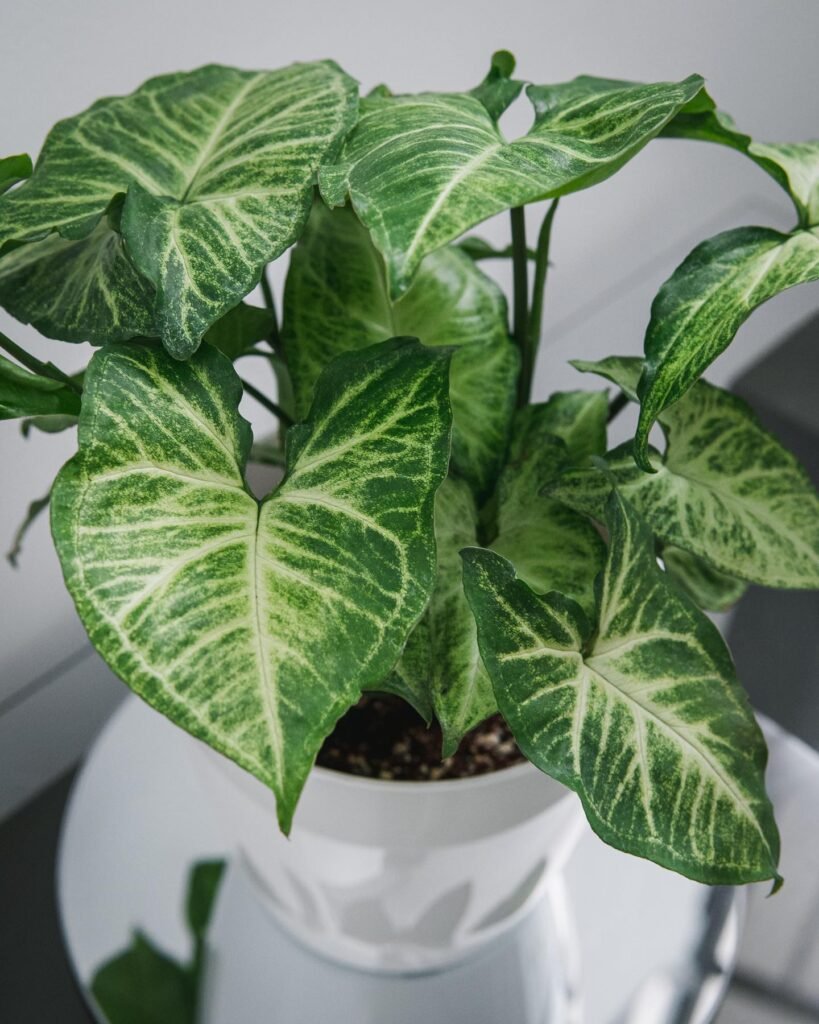
As a devoted plant parent, I understand the importance of watering Syngonium podophyllum (Arrowhead Vine) with care. Syngoniums are unique plants that require regular watering and attention to keep them happy and thriving in your UK home.
When it comes to watering your Syngonium, it’s essential to strike a balance. In spring and summer, the growing season, it’s important to water your plant regularly. Allow the top inch of soil to dry out between waterings to prevent over-watering. This method promotes healthy root growth and prevents the risk of root rot.
Remember, over-watering can be detrimental to your Syngonium’s health, so be cautious. I like to use the “finger test”, where I insert my finger into the soil to check its moisture level before watering.
If the soil feels dry up to your first knuckle, it’s time to water your Syngonium. However, if the soil is still moist, hold off on watering for a few more days.
In winter, the watering frequency can be reduced as the plant’s growth slows down. During this time, allow the soil to dry out a bit more between waterings. This mimics the natural resting period for the plant and prevents over-hydration.
Remember, every plant is unique, and the watering needs may vary based on factors such as humidity, temperature, and the size of your pot. Always monitor your Syngonium’s moisture levels and adjust your watering routine accordingly.
By implementing these watering tips and paying attention to your Syngonium’s needs, you’ll ensure a healthy and flourishing Arrowhead Vine in your UK home.

Fertilizing and Soil for Syngonium podophyllum
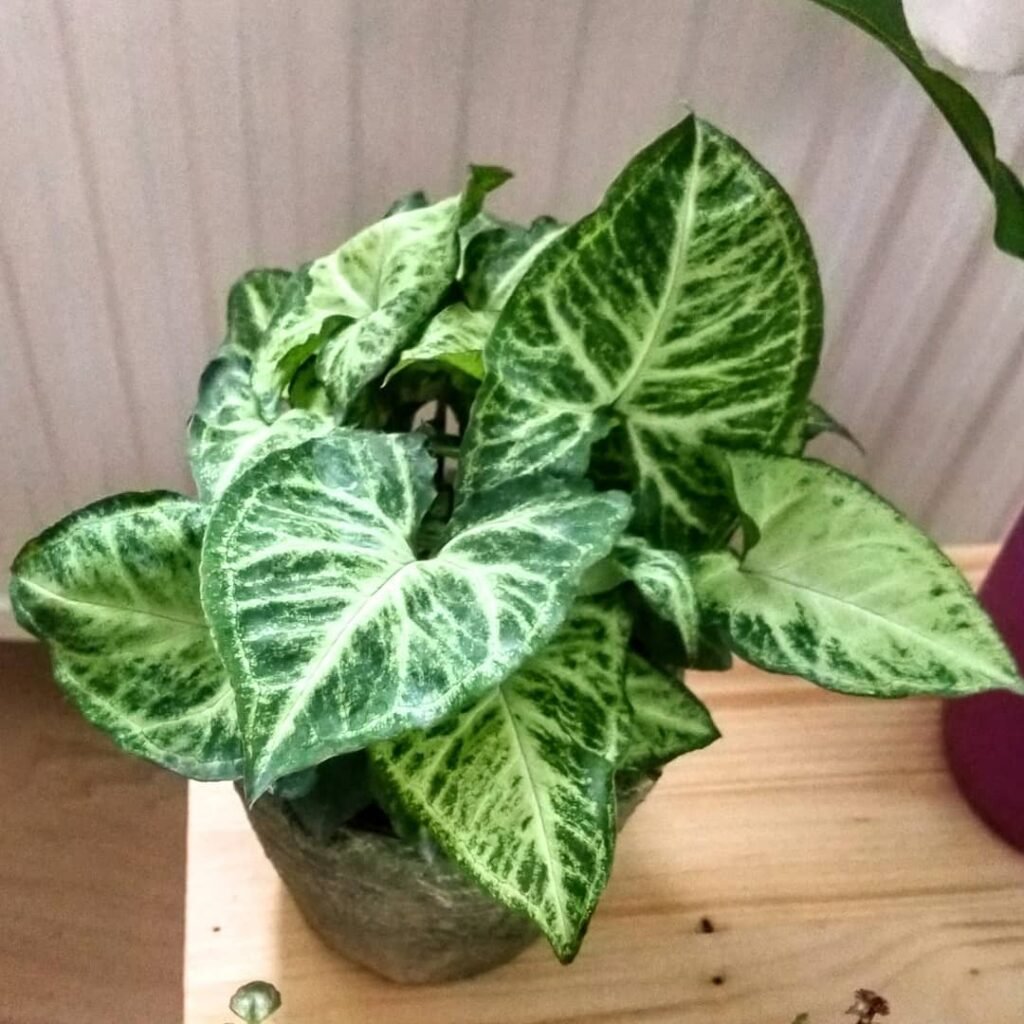

Syngonium podophyllum, known as Arrowhead Vine, is a stunning houseplant that benefits from regular fertilizing during the growing season. To provide the necessary nutrients without overwhelming the plant, I recommend using a balanced, water-soluble fertilizer diluted to half the recommended strength. Apply the diluted fertilizer every few weeks in spring and summer to promote healthy growth and vibrant foliage.
When it comes to the soil, Syngoniums thrive in a well-draining potting mix. It is essential to ensure proper drainage to prevent waterlogging, which can lead to root rot. To enhance drainage, consider adding perlite or coarse sand to the potting mix. This will create a light and airy substrate that allows excess water to escape, keeping the roots healthy and happy.
Additionally, it is good practice to repot your Syngonium every few years to provide fresh soil and enough space for growth. When repotting, choose a pot that is one size larger than the current one to give the plant room to spread its roots. Remember to water the plant 24 hours before repotting to reduce the risk of damage to the delicate root system.

Pruning and Maintenance for Arrowhead Vine


Pruning is an essential aspect of keeping your Syngonium podophyllum, commonly known as the Arrowhead Vine, in optimal health and shape. Regular pruning helps to control its trailing growth habit, encouraging a bushier and more compact appearance. By following these simple maintenance practices, you can keep your Syngonium flourishing:
- Trim leggy or overgrown stems using clean and sharp scissors or pruning shears. This not only helps maintain the plant’s overall shape but also stimulates new growth.
- Pinching back the tips of the plant is an effective way to promote branching and encourage fuller foliage. It also helps to maintain a more compact and attractive appearance.
- It is best to carry out pruning during the growing season for optimal results. This is when the plant is actively producing new growth and has the capacity to heal and recover quickly.
Regular pruning is crucial for keeping your Arrowhead Vine in good condition. By removing any excess growth or leggy stems, you can encourage a bushier and more attractive appearance. Remember to trim with precision, using clean tools, and prune during the growing season to support healthy growth.

Propagating Syngonium podophyllum (Arrowhead Vine)

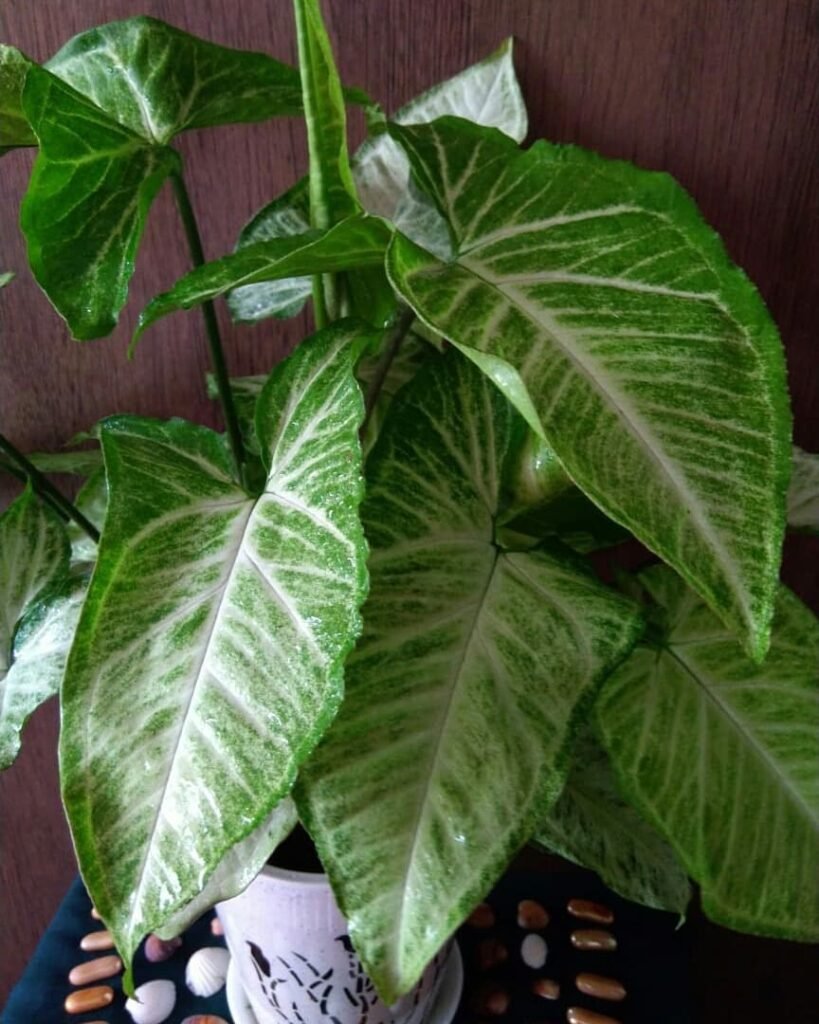
Propagating Syngonium podophyllum, also known as the Arrowhead Vine, is a straightforward and gratifying method to increase your collection of plants. By following a few simple steps, you can generate new plants from stem cuttings and observe their flourishing growth.
To begin the propagation of Syngonium podophyllum, select a healthy stem from the mother plant. Identify a stem that possesses at least one leaf and a node – a small bump on the stem where new roots will emerge.
Here’s a piece of advice: Employ clean and sharp scissors or pruners to prevent harm to the stem.
With the scissors, snip the stem just below a node. This action will supply the essential component for the development of roots. It’s crucial to execute a clean and straight cut to foster successful propagation.
Bear in mind: A straight cut offers a larger area for the growth of roots.
After obtaining your stem cutting, you have the option to choose between two methods of propagation: water or moist soil.
For water propagation:
- Position the stem cutting in a jar or glass brimming with water, ensuring the node is submerged while the leaves stay above the waterline. Opting for a clear container allows for the easy monitoring of root growth. Situate the container in an area with ample light, but away from direct sunlight. Roots are expected to commence development within a couple of weeks.
For moist soil propagation:
- Arrange a small pot or tray with moist potting soil. Fashion a hole in the soil and insert the stem cutting, ensuring the node is covered and the leaf protrudes above the soil surface. Gently compact the soil around the stem to secure it. The soil should be kept consistently moist, without becoming waterlogged. Place the pot or tray in a location that is warm and well-lit, yet shielded from direct sunlight. Roots should start to appear within a few weeks.
Regardless of the chosen propagation method, maintaining a warm and humid environment is key to encouraging root growth. Covering the container with a plastic bag or employing a propagator can create a mini greenhouse effect. Remember: Spring or summer represents the optimal time for propagating Syngonium podophyllum, coinciding with the plant’s period of active growth.
Once the roots have formed, typically after a few weeks, you can delicately transplant the new plant into a pot filled with well-draining soil. Handle the fragile roots gently to prevent damage. Water the newly potted plant and position it in a suitable spot that receives bright, indirect light.
Propagating Syngonium podophyllum offers a fulfilling and economical way to enlarge your plant collection. With a bit of patience and attentiveness, you will be rewarded with new plants that exhibit the distinctive charm of this beloved houseplant.

Repotting Tips for Syngonium podophyllum

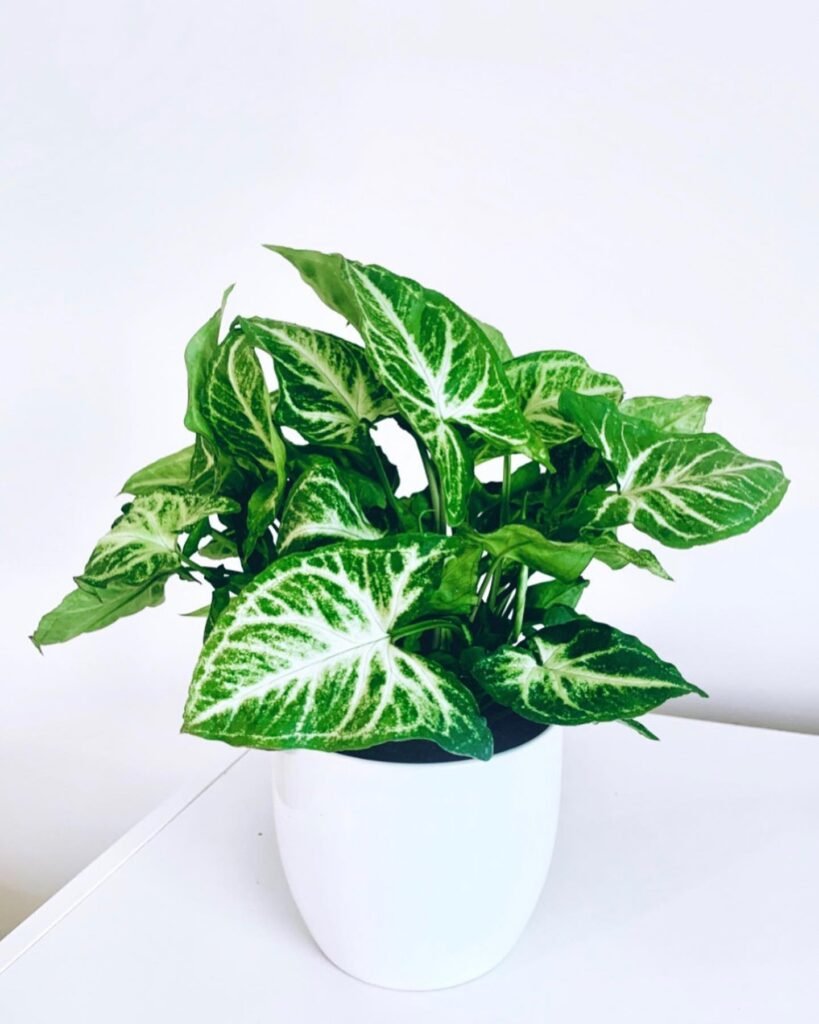
Repotting Syngonium podophyllum is an essential part of caring for this beautiful plant. It should be done every few years to provide fresh soil and ample space for growth. The frequency of repotting depends on the size of the plant and your desired outcome.
If you want a bushier and more compact Syngonium, repotting may only be necessary every two years. However, for larger vines and a more expansive display, repotting annually may be required.
Prior to repotting, it is crucial to water the plant thoroughly, approximately 24 hours in advance. This helps to reduce the risk of damaging the delicate roots and ensures a successful transition.
When selecting a new pot, choose one that is slightly larger than the current container. This will provide sufficient room for the roots to expand without overwhelming the plant.
During the repotting process, gently remove the Syngonium from its old container, being careful not to disturb the roots excessively. Loosen the root ball and inspect for any signs of damage or disease.
Fill the new pot with a well-draining potting mix suitable for houseplants. Adding perlite or coarse sand can improve the drainage and aeration of the soil.
Place the Syngonium in the new pot, ensuring that the roots are spread evenly. Add additional potting mix around the sides and gently firm it down. Avoid compacting the soil too tightly, as this can hinder root growth.
After repotting, water the plant thoroughly and allow any excess water to drain away. Place the Syngonium in a suitable location that provides the recommended light conditions for optimum growth.
Remember, repotting Syngonium podophyllum is an opportunity to refresh its growing environment and support its overall health. By following these repotting tips, you can help your Arrowhead Vine thrive and continue to bring beauty to your home.
 Did you know the Arrowhead Vine changes leaf shapes as it grows? Initially arrow-shaped, they evolve into complex forms to better capture sunlight. Originating from tropical rainforests, this plant adapts to its environment, showcasing remarkable growth and adaptability. It’s not just a lovely houseplant but a lesson in change!
Did you know the Arrowhead Vine changes leaf shapes as it grows? Initially arrow-shaped, they evolve into complex forms to better capture sunlight. Originating from tropical rainforests, this plant adapts to its environment, showcasing remarkable growth and adaptability. It’s not just a lovely houseplant but a lesson in change!
Common Issues with Syngonium podophyllum
When caring for Syngonium podophyllum, it’s important to be aware of common issues that can arise. By understanding and addressing these problems, you can ensure the health and vitality of your Arrowhead Vine.
One common issue is stunted growth, which can be caused by a lack of proper care or unfavorable growing conditions. This often occurs when the plant doesn’t receive enough light or nutrients. To remedy this, ensure your Syngonium podophyllum is placed in a well-lit area and provide it with a balanced fertilizer for optimal growth.
“Stunted growth in Syngonium podophyllum is often a sign of inadequate lighting or nutrition. Ensure the plant receives sufficient light and nutrient-rich soil to promote healthy growth.”
Another issue to watch out for is crispy or brown leaves, which is often a result of underwatering. Syngonium podophyllum prefers slightly moist soil, so it’s important to water it regularly. Monitor the moisture level of the soil and adjust your watering schedule accordingly.
Yellowing lower leaves can also be a common problem, usually indicating overwatering. Syngoniums are susceptible to root rot if the soil is consistently saturated. To prevent this, allow the top inch of soil to dry out between waterings and ensure the pot has proper drainage.
Leaf blotches and wilting can occur due to various factors, including nutrient deficiencies, pests, or environmental stress. Inspect your Syngonium podophyllum regularly for signs of pests, such as mealybugs or spider mites. Treat any infestations promptly with appropriate insecticides or natural remedies.
Low humidity can cause brown foliage in Syngonium podophyllum. These plants thrive in environments with higher humidity levels. To increase humidity, you can mist the leaves regularly or place a tray of water near the plant.
By regularly checking the moisture level of the soil, misting the plant, and maintaining a good level of humidity, you can prevent these common issues and help your Syngonium podophyllum thrive.
Helpful Videos about Syngonium podophyllum (Arrowhead Vine)
Explore these marvellous videos I’ve come across on tending to the Syngonium podophyllum, more commonly known as the Arrowhead Vine. They’re full of guidance to make looking after your plant straightforward. An excellent resource for gardening novices!
- Syngonium COMPLETE Care Guide | How to Grow Syngonium podophyllum arrowhead plant
- Ultimate SYNGONIUM (Arrowhead Vine) CARE Guide
- Syngonium podophyllym care and propagation
FAQ about Caring for Syngonium podophyllum (Arrowhead Vine)

Ever wondered how to care for your Syngonium podophyllum (commonly known as the Arrowhead Vine)? You’re in the right spot! I’ve gathered all the essential tips to make nurturing your Arrowhead Vine effortless. Whether it’s finding the perfect spot for it to thrive or understanding its watering needs, I’ve got you covered.
The Arrowhead Vine thrives in bright, indirect light. Avoid direct sunlight, as it can scorch the leaves. A spot near a north or east-facing window is ideal. In darker months, consider using a grow light to supplement light levels.
Water when the top inch of soil feels dry to the touch. Over-watering can lead to root rot, so ensure your pot has good drainage. In the UK, this might mean watering less frequently during the cooler, less sunny months.
A well-draining, peat-based potting mix is perfect. You can mix in perlite or vermiculite to enhance drainage. This plant prefers a slightly acidic to neutral pH.
Syngonium podophyllum enjoys high humidity. In the drier indoor air of UK homes, especially in winter, mist the leaves regularly or place a humidifier nearby. Another method is placing the pot on a tray filled with pebbles and water, ensuring the pot sits above the water level.
Feed your plant every 4-6 weeks during the growing season (spring to summer) with a balanced, water-soluble fertiliser. Reduce feeding in autumn and winter to every 8-10 weeks.
Prune in spring or early summer to encourage bushier growth. Use clean, sharp scissors to cut back any leggy stems. This will keep your plant looking full and healthy.
Yes, it’s quite easy to propagate through stem cuttings. Choose a healthy stem with at least one node and a few leaves. Cut below the node and place in water or moist soil. Roots should form in a few weeks.
Yellowing leaves, mushy stems, and a general look of wilt are common signs. Allow the soil to dry out more between waterings and ensure your pot has adequate drainage.
Repot in spring every 2-3 years or when the roots outgrow the pot. Choose a pot one size larger with good drainage. Gently tease out the roots if they are circling the rootball and repot using fresh potting mix.
Spider mites, aphids, and mealybugs can be problematic. Keep an eye out for signs of infestation, such as webbing, sticky leaves, or visible insects. Treat with a suitable insecticidal soap or neem oil.
Brown tips can be a sign of low humidity or fertiliser burn. Increase humidity around the plant and ensure you are not over-fertilising.
While it can survive in low light, growth may be slower, and the leaves may lose their vibrant colour. It’s best to provide bright, indirect light for optimal growth.
Yes, it is toxic if ingested. Keep it out of reach of pets and small children.
Adequate light is key to vibrant leaf colours. Too little light can make the leaves revert to a more solid green. Avoid direct sunlight, which can bleach the leaves.
It prefers temperatures between 18°C and 27°C. Protect it from drafts and sudden temperature changes, which the UK climate can sometimes present.
Legginess is often a sign of insufficient light. Move your plant to a brighter location and consider pruning back the leggiest stems to encourage fuller growth.
In the summer, yes, but ensure it’s in a sheltered, shaded spot. However, it must be brought indoors before temperatures drop in the autumn.
Absolutely! Syngonium podophyllum adapts well to terrarium environments due to its love for humidity. As a hanging plant, its trailing vines can create a stunning visual effect. Just ensure it has enough space to grow and receive sufficient light.
Yes, dust can accumulate on the leaves, hindering photosynthesis. Gently wipe the leaves with a damp cloth or sponge to keep them clean. This not only helps the plant breathe better but also keeps it looking its best.
I hope this guide has offered you valuable insights into caring for your Syngonium podophyllum (Arrowhead Vine). If there’s something you’re still curious about, don’t hesitate to drop your questions below. I’m here to help. Remember, every gardener begins with bare soil; it’s the journey of growth and discovery alongside our leafy friends that truly enriches our experience.
Conclusion
Syngonium podophyllum, commonly known as Arrowhead Vine or Goosefoot, is a popular and easy-to-care-for houseplant that can add beauty and vibrancy to any indoor space. With its striking and varied foliage, this plant is a delightful addition to your UK home.
To ensure the health and well-being of your Syngonium podophyllum, there are a few essential care tips to keep in mind. Providing the right amount of light is crucial. Place your Arrowhead Vine in a location with bright, indirect sunlight to achieve vibrant leaf colors and faster growth. Avoid exposing it to direct sunlight, as this can scorch the leaves.
Water your Syngonium podophyllum regularly, allowing the top inch of soil to dry out between waterings. Overwatering can lead to root rot, so it’s important to strike the right balance. During the winter months, when growth slows down, you can reduce the watering frequency.
Maintaining your Arrowhead Vine’s shape and promoting bushier growth can be achieved through regular pruning. Trim leggy or overgrown stems and pinch back the tips to encourage branching and fuller foliage. Additionally, consider propagating your Syngonium podophyllum through stem cuttings to expand your plant collection.
By following these care tips and providing the appropriate levels of light, water, and maintenance, you can cultivate a thriving Syngonium podophyllum in your UK home. Enjoy the beauty and benefits of this charming indoor plant. Happy growing!

